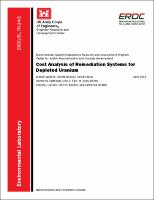Please use this identifier to cite or link to this item:
https://hdl.handle.net/11681/7027Full metadata record
| DC Field | Value | Language |
|---|---|---|
| dc.contributor | Environmental Quality and Installations Program (U.S.) | - |
| dc.contributor | United States Military Academy. Department of Systems Engineering | - |
| dc.contributor | Center for Nation Reconstruction and Capacity Development | - |
| dc.contributor.author | Farr, John V. | - |
| dc.contributor.author | Martin, W. Andy | - |
| dc.contributor.author | Larson, Steven L. | - |
| dc.contributor.author | Ballard, John H. | - |
| dc.contributor.author | Nestler, Catherine C. | - |
| dc.contributor.author | Mackey, Jarrett | - |
| dc.contributor.author | Maki, Kahlan | - |
| dc.contributor.author | Walters, Joseph | - |
| dc.contributor.author | Northcutt, Raymond | - |
| dc.creator | Applied Research Associates | - |
| dc.date.accessioned | 2016-03-28T14:30:41Z | - |
| dc.date.available | 2016-03-28T14:30:41Z | - |
| dc.date.issued | 2014-04 | - |
| dc.identifier.uri | http://hdl.handle.net/11681/7027 | - |
| dc.description | Technical Report | - |
| dc.description | Abstract: The United States (US) Army and the other services are mandated to comply with all federal, state, and local environmental regulations. Recent concerns over potential human exposure to depleted uranium (DU) at US Army test ranges, primarily, have resulted in research into numerous innovative remediation technologies. Developing methods and processes for estimating the life cycle costs (LCC) of implementing these various techniques is important in identifying cost-effective solutions. Total ownership costs (TOC) models were developed for four candidate alternatives using two new technologies; Alternative 1- Physical Separation and Chemical Treatment; Alternative 2- Selective Excavation; Alternative 3- Selective Excavation with Physical Separation and Chemical Treatment; Alternative 4- Containment and Monitoring. The team chose a generic sandy soil site roughly 10 miles square for cost estimates. A bottom up estimate was applied to all alternatives in order to get a baseline cost; Alternative 3 had the best estimate for an efficient and effective remediation method. A cost-estimating relationship was generated and simulation-based costing (SBC) was then applied to Alternative 3. Lastly, two alternatives were evaluated for DU remediation of catchboxes. Identifying the key cost drivers from SBC modeling is significant to future investments in research and development. | - |
| dc.publisher | Environmental Laboratory (U.S.) | - |
| dc.publisher | Engineer Research and Development Center (U.S.) | - |
| dc.relation | http://acwc.sdp.sirsi.net/client/en_US/search/asset/1034161 | - |
| dc.relation.ispartofseries | ERDC/EL TR ; 14-5. | - |
| dc.rights | Approved for public release; distribution is unlimited. | - |
| dc.source | This Digital Resource was created in Microsoft Word and Adobe Acrobat | - |
| dc.subject | Bottom up estimate | - |
| dc.subject | Cost estimating relationships | - |
| dc.subject | Depleted uranium | - |
| dc.subject | Munitions | - |
| dc.subject | Ordnance | - |
| dc.subject | Life cycle costing | - |
| dc.subject | Simulation-based costing | - |
| dc.subject | Total ownership costs | - |
| dc.subject | Site remediation | - |
| dc.subject | Environmental Quality and Installations Research and Development Program (U.S.) | - |
| dc.subject | Center for Nation Reconstruction and Capacity Development | - |
| dc.title | Cost analysis of remediation systems for depleted uranium | - |
| dc.type | Report | en_US |
| Appears in Collections: | Technical Report | |
Files in This Item:
| File | Description | Size | Format | |
|---|---|---|---|---|
| ERDC-EL-TR-14-5.pdf | 8.52 MB | Adobe PDF |  View/Open |